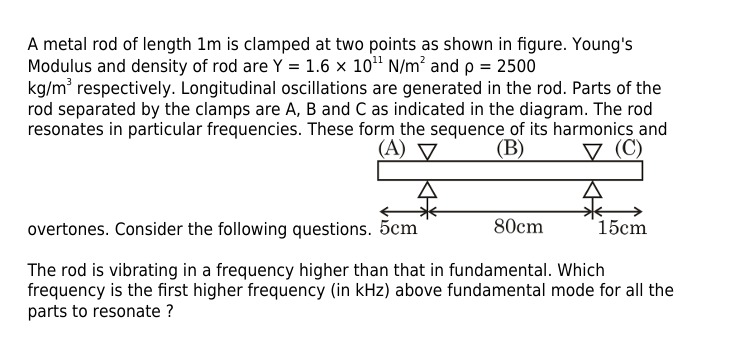Question
Question: The rod is vibrating in a frequency higher than that in fundamental. Which frequency is the first hi...
The rod is vibrating in a frequency higher than that in fundamental. Which frequency is the first higher frequency (in kHz) above fundamental mode for all the parts to resonate ?

40
80
120
160
120
Solution
The speed of longitudinal waves in the rod is given by v=ρY. Given Y=1.6×1011 N/m² and ρ=2500 kg/m³.
v=25001.6×1011=64×106=8000 m/s.
The rod is clamped at 5 cm and 85 cm from one end, dividing it into three parts:
- Part A: Length LA=5 cm = 0.05 m. Free at one end, clamped at the other.
- Part B: Length LB=85−5=80 cm = 0.80 m. Clamped at both ends.
- Part C: Length LC=100−85=15 cm = 0.15 m. Clamped at one end, free at the other.
For longitudinal oscillations, the clamped ends are displacement nodes, and the free ends are displacement antinodes.
The allowed frequencies for each part are:
-
Part A (Free-Clamped): fA=(2nA−1)4LAv, where nA=1,2,3,...
fA=(2nA−1)4×0.058000=(2nA−1)0.28000=(2nA−1)×40000 Hz =(2nA−1)×40 kHz.
Possible frequencies for A: {40,120,200,280,360,440,520,600,...} kHz.
-
Part B (Clamped-Clamped): fB=nB2LBv, where nB=1,2,3,...
fB=nB2×0.808000=nB1.68000=nB×5000 Hz =nB×5 kHz.
Possible frequencies for B: {5,10,15,20,...,40,...,120,...,200,...,600,...} kHz.
-
Part C (Clamped-Free): fC=(2nC−1)4LCv, where nC=1,2,3,...
fC=(2nC−1)4×0.158000=(2nC−1)0.68000=(2nC−1)×340000 Hz =(2nC−1)×340 kHz.
Possible frequencies for C: {340,40,3200,3280,120,3440,3520,200,...} kHz.
For all parts to resonate at the same frequency f, the frequency must be common to all three sets.
f=(2nA−1)×40=nB×5=(2nC−1)×340.
From (2nA−1)×40=nB×5, we get 8(2nA−1)=nB. Since nA≥1, 2nA−1 is an odd integer ≥1. So nB must be a multiple of 8. The common frequencies for A and B are the odd multiples of 40 kHz.
From (2nA−1)×40=(2nC−1)×340, we get 3(2nA−1)=(2nC−1). Let kA=2nA−1 and kC=2nC−1. Both kA and kC are odd integers ≥1. We have 3kA=kC.
Since kA is an odd integer (1,3,5,...), kC must be an odd integer that is a multiple of 3 (3,9,15,...). This is consistent with kC being an odd integer.
The common frequencies for A and C are f=40kA, where kA is an odd integer. These are {40,120,200,280,...} kHz.
We need frequencies common to A, B, and C. These frequencies must be in the set {40,120,200,280,...} kHz, and also be multiples of 5 kHz (from part B). Since all numbers in the set {40,120,200,280,...} are multiples of 40, they are also multiples of 5.
So, the common resonant frequencies for all three parts are {40,120,200,280,360,440,520,600,...} kHz.
The fundamental frequency for all parts to resonate is the lowest frequency in this set, which is 40 kHz.
The question asks for the first higher frequency above the fundamental mode for all parts to resonate. This is the next frequency in the common set, which is 120 kHz.
At 40 kHz:
f=40=(2nA−1)×40⟹2nA−1=1⟹nA=1 (fundamental for A)
f=40=nB×5⟹nB=8 (8th harmonic for B)
f=40=(2nC−1)×340⟹3=2nC−1⟹2nC=4⟹nC=2 (first overtone for C, since nC=1 is fundamental)
At 120 kHz:
f=120=(2nA−1)×40⟹2nA−1=3⟹nA=2 (first overtone for A)
f=120=nB×5⟹nB=24 (24th harmonic for B)
f=120=(2nC−1)×340⟹120×403=2nC−1⟹9=2nC−1⟹2nC=10⟹nC=5 (fourth overtone for C)
The fundamental frequency for all parts to resonate is 40 kHz. The first higher frequency for all parts to resonate is 120 kHz.
